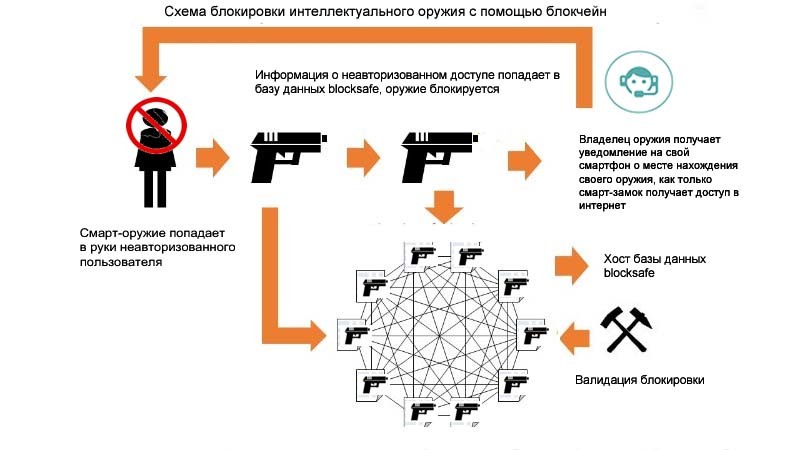Over the past 20 years, technologists have made a lot of efforts to solve the problem of weapons security, and not without reason: in 2015 alone, about 300 people died from firearms (and not as a result of military actions, but simply from shots of inadequate personalities in a completely peaceful time) . Their efforts have kept pace with the development of Bluetooth technology and Wi-Fi , radio frequency sensors and the Internet of Things (IoT). However, things are there.

Before we explain how the Internet of things and the blockchain are related to weapons, let's dive into the theme of the weapon itself. In April of this year, Obama allocated funding for the study of smart weapons. Smart weapons are a technological solution to prevent violence at the hands of those who should not hold these weapons: thieves, children, or any unauthorized users. A smart gun is a firearm that includes a security feature or function that allows it to fire only when activated by an authorized user. These security features can prevent misuse, accidents, theft of weapons, the use of weapons against the owner, self-harm. Smart weapons can distinguish authorized users from unauthorized users in various ways, including using RFID chips or other proximity markers, fingerprint recognition, or mechanical locks. 
')
Blockchain - answer to security questions

Before the advent of intelligent weapons, there was no decentralized infrastructure of IoT devices, so
smart devices , such as weapons, had too many security risks. Intellectually weapons destroy these barriers.
The blockchain system provides the ability to enable, disable, track and disarm firearms without
any centralized control and reporting. This is primarily a project to create software, develop infrastructure to support
smart hardware
devices that manufacturers and
3D printing projects use to improve the security and defense capability of firearms. This is a peer-to-peer network that uses a combination of Lisk, BitTorrent and Telehash.
In a nutshell, when a weapon fires, the technology “shotspot” accepts and records data. Notifications at the same time receive and emergency services. Several
"shotspot" work
together to detect and defuse weapons.
When the
smart device was initially set up
, the owner's
Bluetooth authentication is configured through a special application, and all authorized users are added by the device owner; data about them is stored locally. The authentication method may vary depending on the device and manufacturer. The calculation of the number of charges remaining in the gun and the authentication parameters are stored in real time along with other data that the device owner wants to record. For example, it can be the date, time, and place recorded by encryption in the local register of the device.
When the device accesses the Internet, the data is synchronized with the network (there is also
something from dew computing, isn’t it? :) and the owner of the device receives notifications, such as push, SMS or emails, in accordance with the selected settings. Data is encrypted using a key database on the network. So, only those who have data on the device, received from the owner, can view the information on it.
The purpose of creating such a weapon network is to support the functions of
smart devices , such as event logging and remote control, which can only be carried out by the owner of the device. For example, a
smart lock can be used on a weapon, which will warn the owner about unauthorized actions with a weapon. This will help the owner of the device to control its use and placement.
To secure, but not "burden"
The technology will include locks that are mounted on the gun. Custom prototypes of smart devices are being developed, but more emphasis is placed on the development and maintenance of the network and infrastructure. The network will provide SDK,
API and support for other manufacturers.
Thus, the goal of smart weapons developers is to create a secure decentralized infrastructure to reduce activity regarding the illegal use of firearms. Smart weapons can prevent weapons from being stolen and used in
force majeure situations against their masters. Unfortunately, the development of such weapons is in every way hampered by the US legislative bodies, who believe that smart weapons will violate the human rights to acquire, carry and use weapons then and as they please.
Predecessors
By the way, the prototype of the modern design is the electronic weapon O'Dwyer VLe, which included the technology of biometric authorization. The biometric authorization technology was patented by NJIT and made it possible to create an “impersonal” pistol that is both protected from children and adapted for one owner, so no one else can use it. This is the first 100% electronic pistol in the world, which was created using new ballistic technologies developed in Australia: the pistol has no moving parts, there is no separate store, there is no ammunition supply.
A seven-shot pistol can shoot several rounds with one pull of the trigger at the rate of up to 60,000 rounds per minute. The design of the gun includes a biometric system based on an electronic key that recognizes only authorized users who wear a special
transponder ring . The electronic gun served as a precedent for the beginning of the use of personalization technologies in the original design of the weapon, and not as added elements.


